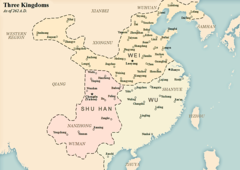3rd century
This articleneeds additional citations forverification.(March 2019) |
| Millennium |
|---|
| 1st millennium |
| Centuries |
| Timelines |
| State leaders |
| Decades |
| Categories: |
|
Births–Deaths Establishments–Disestablishments |



The3rd centurywas the period from AD201(represented by theRoman numeralsCCI) to AD 300 (CCC) in accordance with the Julian calendar.
In this century, theRoman Empiresaw acrisis,starting with the assassination of the Roman EmperorSeverus Alexanderin 235, plunging the empire into a period of economic troubles, barbarian incursions, political upheavals, civil wars, and the split of the Roman Empire through theGallic Empirein the west and thePalmyrene Empirein the east, which all together threatened to destroy the Roman Empire in its entirety, but the reconquests of the seceded territories by EmperorAurelianand the stabilization period under EmperorDiocletiandue to the administrative strengthening of the empire caused an end to the crisis by 284. This crisis would also mark the beginning ofLate Antiquity.
InPersia,theParthian Empirewas succeeded by theSassanid Empirein 224 afterArdashir Idefeated and killedArtabanus Vduring theBattle of Hormozdgan.The Sassanids then went on to subjugate many of the western portions of the decliningKushan Empire.
InChina,thechaosthat had been raging since 189 would ultimately continue to persist with the decisive defeat ofCao Caoat theBattle of Red Cliffsin 208, which would increasingly end the hopes of unification and lead to the tripartite division of China into three main empires;Shu,Wu,andWei,colloquially known as theThree Kingdomsperiod, which started in 220 with the formal abdication ofEmperor Xian of Hanto Cao Cao's son,Cao Pi,thereby founding Wei, which would go on toconquer Shuin 263, but would ultimately be united again under theJin dynasty,headed by theSima clan,who would usurp Wei in 266, andconquer Wuin 280.
In other parts of the world,Koreawas ruled by theThree Kingdoms of Korea.Japanentered theKofun period.The Southeast Asian mainland was mostly dominated byFunan,the first kingdom of theKhmer people.InIndia,theGupta Empirewas on the rise towards the end of the century. InPre-Columbian America,theAdena cultureof theOhio Rivervalley declined in favor of theHopewell culture.TheMaya civilizationentered itsClassic Era.
Roman Empire[edit]
After the death ofCommodusin the late previous century the Roman Empire was plunged into a civil war. When the dust settled,Septimius Severusemerged as emperor, establishing theSeverandynasty. Unlike previous emperors, he openly used the army to back his authority, and paid them well to do so. The regime he created is known as theMilitaryMonarchyas a result. The system fell apart in the230s,giving way to a fifty-year period known as the Military Anarchy or theCrisis of the Third Century,following the assassination of the 28-year-old emperorSeverus Alexander(the last emperor of the Severan dynasty), where no fewer than twenty emperors held the reins of power, most for only a few months. The majority of these men were assassinated, or killed in battle, and the empire almost collapsed under the weight of the political upheaval, as well as the growingPersianthreat in the east. Under its new Sassanid rulers, Persia had grown into a rival superpower, and the Romans would have to make drastic reforms in order to better prepare their state for a confrontation. These reforms were finally realized late in the century under the reign ofDiocletian,one of them being to divide the empire into an eastern and western half, and have a separate ruler for each.
Events[edit]

- TheKingdom of Funanreaches its zenith.
- TheGothsmove fromGothiscandzatoUkraine,giving birth to theChernyakhov culture.
- Menorahs and Ark of the Covenant,wall painting in a Jewish catacomb,Villa Torlonia (Rome),are made.
- TheCoptic periodbegins.
- Siddhartha in the Palace, detail of a relief fromNagarjunakonda,Andhra Pradesh,India,is made. Now kept atNational Museum, New Delhi.
- Two statuettes,Jonah Swallowed and Jonah Cast Up,of a group from the easternMediterranean,probablyAsia Minor,are made. Now kept at TheCleveland Museum of Art,Ohio.
- TheMagerius Mosaicis made. Now kept at theSousse Archaeological Museum,Tunisia.[1]
- Early 3rd century: Burial in catacombs becomes commonplace.
- 208:the Chinese navalBattle of Red Cliffsoccurs.[2]
- 211–217:Caracalla,Roman Emperor.
- 212:Constitutio Antoninianagrantscitizenshipto all free Roman men.
- 212–217:Baths of Caracalla.
- 220:TheHan dynastycomes to an end with establishment of theThree Kingdomsin ancientChina.[3]
- 220–280:TheThree Kingdomsperiod.[4]
- 222–235:Alexander Severus,Roman Emperor.

Rock relief ofArdashir Ireceiving the ring of kingship by theZoroastriansupreme godAhura Mazda. - 224:Ardashir Iof theSassanid dynastyconquers theParthian empireat theBattle of Hormozdgan.
- 230–232:Sassanid dynastyofPersialaunches a war to reconquer lost lands in theRoman east.
- 234:Zhuge Liangdies of illness at the standoff ofWuzhang Plains.
- 235–284:Crisis of the Third Centuryshook theRoman Empire.
- 241:TheKingdom of Hatradissolved after theFall of Hatrato Persia
- 244:Battle of Xingshiin China.
- 258:Valerian's massacre of Christians.
- 260:RomanEmperor Valerian Iis taken captive byShapur IofPersia.

Political map of China in 262 AD - 263:Cao WeiconquerstheShu HanKingdom.
- 266:TheJin dynastyis founded after the overthrow of theCao Weidynasty bySima Yan.
- 280:TheJin dynastyreunitesChinaunder one empire after theconquestofEastern Wu.
- 284–305:Diocletian,Roman Emperor.
- 291–306:TheWar of the Eight Princes,a civil war by the Sima Clan in China.
- 293:Emperor Diocletian forms theTetrarchyin Rome.
- 300–538:Kofun era,the first part of theKofun periodinJapan.
- Late 3rd century – early 4th century: Good Shepherd, Orants and Story of Jonah, painted ceiling of theCatacombs of Marcellinus and PeterinRome,is made.
Inventions, discoveries, introductions[edit]
- Sarnathbecomes a center ofBuddhistarts inIndia.
- Diffusion ofmaizeas a food crop fromMexicointoNorth Americabegins.
References[edit]
- ^Bomgardner, David L. (2013).The Story of the Roman Amphitheatre.Routledge. p. 211.ISBN9781134707393.
- ^McNab, Chris (2017).Famous Battles of the Ancient World.Cavendish Square Publishing, LLC. p. 74.ISBN9781502632456.
- ^"Han dynasty | Definition, Map, Culture, Art, & Facts".Encyclopedia Britannica.Retrieved17 March2019.
- ^"Three Kingdoms | ancient kingdoms, China".Encyclopedia Britannica.Retrieved17 March2019.
